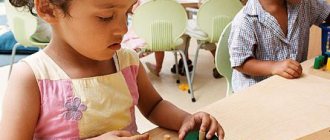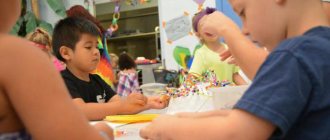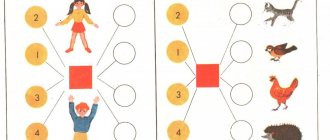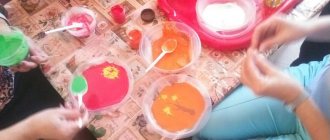Master class for teachers on the topic: “Our health is in our hands!”
The author is a social teacher of the first qualification category, Olga Borisovna Moiseenko. Municipal preschool educational institution "Kindergarten No. 290 of the Dzerzhinsky district of Volgograd (MOU kindergarten No. 290)
Be kind if you want; Be wise if you can; But you should always be healthy. (Confucius)
Goal: to develop in teachers the ability and desire to take care of their health, the need for a healthy lifestyle and emotional well-being as the key to success in teaching.
Tasks: 1. Create conditions for preserving and strengthening the health of teachers. 2. Maintain a favorable psychological climate in kindergarten. 3. To develop teachers’ self-regulation skills, a sense of empathy, a positive attitude, sincerity and openness.
Host: Hello! We hear this word from birth. Every day begins with him. Hello, at first glance, this is the most ordinary word. But it has everything: the light of a smile, the joy of meeting, and wishes for health. Saying: “Hello,” we wish a person to be strong, strong, and healthy. So let's greet each other.
The exercise is carried out in a circle (teachers greet each other by name and say their wishes).
Host: I would like to start with the words of the great Russian teacher V.A. Sukhomlinsky: “Caring for health is the most important work of a teacher. Their spiritual life, worldview, mental development, strength of knowledge, and self-confidence depend on the cheerfulness and vigor of children.”
The preschool period is the most favorable for the formation of a healthy lifestyle. A child’s awareness of his “I”, the correct attitude towards the world, the people around him - all this depends on how conscientiously, lovingly, competently the teacher organizes his work.
A healthy lifestyle is not just the sum of acquired knowledge, but a lifestyle, adequate behavior in various situations. Everything we teach children must be applied in real life. Particular attention should be paid to the following components of a healthy lifestyle:
- exercise, walks
- rational nutrition, compliance with personal hygiene rules: hardening, creating conditions for good sleep;
- friendly attitude towards each other, development of listening and speaking skills,
- medical education, timely visits to the doctor, implementation of various recommendations, passing a medical examination annually;
- formation of the concept “don’t harm yourself.”
An exercise is conducted on the topic “What is health?” Answers from teachers.
Host: So, health is beauty, it is strength and intelligence, a good mood. Health is the greatest wealth. Health is happiness. What should you do to be healthy?
Answers from teachers: -Health is not everything that brings joy, but without health nothing brings joy. — Health is not only good physical shape, but also mental balance. — Health is the ability to satisfy one’s needs within reasonable limits. — Health is needed not only for you, but also for the people you are obliged to help. — Health is a culture of human relations. — Health is a social culture of relationships. — Health is a way of life.
Host: So, there are 10 golden rules for preserving health. • Follow your daily routine! • Pay more attention to nutrition! • Move more! • Sleep in a cool room! • Don't extinguish your anger, let it break out! • Constantly engage in intellectual activity! • Drive away despondency and blues! • React adequately to all manifestations of your body! • Try to get as many positive emotions as possible! • Wish only good things for yourself and those around you!
Host: If you want to be healthy, make friends with physical education, clean air and healthy food. Learn to breathe correctly: calmly, shallowly, measuredly.
The presenter suggests listening to your breathing and determining what it is: superficial, deep, chest or with the participation of the abdominal muscles.
Breathing control is an effective means of influencing muscle tone and emotional centers of the brain. Slow and deep breathing (with the participation of the abdominal muscles) reduces the excitability of the nerve centers and promotes muscle relaxation. Frequent (chest) breathing, on the contrary, ensures a high level of body activity and maintains neuropsychic tension.
Method 1. Imagine that there is a piece of fluff hanging in front of your nose at a distance of 10-15 cm. Breathe only through your nose and so smoothly that the fluff does not flutter.
Method 2. Since in a situation of irritation or anger we forget to exhale normally, try: exhale deeply; hold your breath for as long as you can; take a few deep breaths; hold your breath again.
Teachers use breathing techniques (Teaching methods of breathing control).
1. Mask of surprise. IP: sitting, standing, lying down. With a slow inhalation, gradually raise your eyebrows as high as possible. At the height of inhalation, hold your breath for a second and lower your eyebrows as you exhale.
2. Mask of anger. IP: sitting, standing, lying down. With a slow inhalation, gradually frown your eyebrows, trying to bring them as close as possible. Hold your breath for a second and lower your eyebrows as you exhale.
3. Kiss mask. IP: standing, sitting, lying down. Simultaneously with inhalation, gradually compress your lips (“chicken tail” or embouchure with a tube). Take this effort to its limit. Record the effort, hold your breath for a second, and exhale freely, relax the orbicularis oris muscle.
4. Mask of laughter. IP: standing, sitting or lying down. Squint your eyes slightly, inhale slightly, purse your lips and raise the corners of your mouth - a mask of laughter, and exhale - relax tense muscles. – Exercise “Calming Breathing”. I.P.: While sitting, take a breath - stick your stomach forward (“inflate” your big belly) at the count of 1-2-3-4; holding your breath for a count of 1-2; exhale - pull in the stomach at the count of 1-2-3-4. (duration 3-5 minutes).
Host: Our profession obliges us to talk a lot. Overstrain of the vocal cords can cause throat diseases: laryngitis, pharyngitis. Performing simple exercises will help strengthen the muscles of the larynx.
I suggest you perform a set of breathing and vocal exercises to strengthen the muscles of the larynx. -Click your tongue loudly and quickly, quietly and slowly. −Try to reach your chin with your tongue several times. −Try to yawn with your mouth closed, as if hiding the yawn from others. −Open your mouth as wide as possible, relax your muscles a little and gently lower your head down. Return to the starting position. −Make movements with your lips, mentally saying “a-o-e.”
Teachers perform a set of exercises.
Presenter: Exercises that will not take much time and do not require special equipment will help relieve muscle and psychological tension. When you get home, turn on calm music and do exercises to relieve muscle and psychological tension, which we will now show you.
Teachers perform a set of exercises. to relieve muscle and psychological tension.
Leading. Perform all movements very slowly, smoothly, avoiding pain. Breathe evenly and calmly. Try to maintain each pose for 30 seconds. •Straighten your shoulders. Stand on tiptoes, raise your arms and stretch your whole body up. •Do a half squat with your knees slightly bent. Extend your arms in front of you and lean forward, keeping your back completely straight. •From the same position, move your arms straight back. Pull your neck and chin forward. •Lean forward, move your arms to the sides, straighten your knees. Stretch. •Place your feet together, lean forward, clasp your knees with your hands and try to touch them with your nose. •Perform two turns of your head left and right (chin almost touches chest).
Host: To be healthy, you need to learn to alternate work with active recreation. For example, when you offer children a warm-up or physical education session, do it together with the children. During your walk, don’t just organize outdoor games, but play them with your children.
Presenter: A finger massage can help the body resist illness, feel cheerful and full of energy, relax and relieve symptoms of fatigue. Each finger is responsible for the functioning of a specific organ in our body. Thumb – stimulates brain activity; Index finger – improves stomach function; Middle – intestines and spine; Unnamed – improves liver function; Mezenets - helps the heart function.
Each finger is massaged separately towards its base along the dorsal, palmar and lateral surfaces. We start the massage with stroking, then rubbing, the next step is kneading and end with stroking again.
Teachers perform finger massage.
Presenter: Teachers go to the basket, take tokens, according to which they are divided into two teams: “Dexterous” and “Fast”. Motto of the event: There is noise and bustle in the kindergarten today. The teachers decided everything: Health is beauty!
- Competition “Swallow” (Who can stand on one leg longer in the swallow position.)
- Competition “Proverbs and Sayings” (Team members take turns naming proverbs and sayings about health. The team whose answer was the last wins)
- Relay race “Pairs with a hoop” (Teachers in pairs run to a landmark. One holds the hoop, the second crawls up, then the second holds it, the first crawls up. They return running.)
Host: Everyone knows that a good mood is associated with health. Laughter prolongs life. When we laugh, our body produces endorphins - pleasure hormones. Think positively! Learn to control your thoughts and when negative ones appear, immediately replace them with positive ones.
Now I offer you several negative beliefs from our daily life, which you will have to turn into AFFIRMATIONS in the process of group work.
“Negative Beliefs” 1. No one values me at work 2. My colleagues annoy me 3. I’m afraid that I won’t succeed... 4. I can’t look at myself in the mirror 5. I’m disappointed in life...
Group responses.
- People love me at work
- I am surrounded only by positive and cheerful people
- Everything works out just great for me.
- I like the way I look
- I love life!
View the presentation “I can be healthy - I will help myself.”
1. Start a new day with a smile and morning exercises. 2. Maintain a daily routine yourself and demand this from your children. 3. Remember: a smart book is better than aimless watching TV. 4. Love your child - he is yours. Respect your family members, they are your traveling companions. 5. A positive attitude towards yourself is the basis of psychological survival. 6. There are no bad children, only bad actions. 7. Personal example for a healthy lifestyle is better than any morality. 8. Use natural hardening factors to stay healthy. 9. Remember: simple food is healthier than elaborate dishes. 10. The best type of recreation is a walk with the family in the fresh air, the best entertainment for a child is playing together with parents.
Host: Now we will perform a psychotechnical exercise with you, with which you can relieve fatigue, gain internal stability and feel self-confidence.
The exercise is called “Inner Ray”.
Find a comfortable position, sit comfortably. (Calm music is turned on).
Imagine that inside your head, in the upper part, a light ray appears, which slowly and consistently moves from top to bottom and slowly, gradually illuminates your face, neck, shoulders, hands with a warm, even and relaxing light. As the beam moves, wrinkles are smoothed out, tension in the back of the head disappears, the fold on the forehead is weakened, the clamps in the corners of the lips are loosened, the shoulders are lowered, the neck and chest are freed. The inner ray, as it were, forms a new appearance - a calm, liberated person, satisfied with himself, his life and his profession.
And now together, without opening our eyes, we say “I have become a new person!” I became young and strong, calm and stable! I will do everything well!”
Exercise (Plot fairy tale “Multi-colored stars”). (Calm music is turned on, stars are hung against the background of the “sky.”)
High in the dark sky, in one huge starry meadow, there lived - there were stars. There were a lot of them, and all the stars were very beautiful. They glowed and sparkled, and people on earth admired them every night. But all these stars were of different colors. There were red stars here, and they gave courage to those born under their light. There were blue stars here - they gave people beauty. There were also yellow stars in the clearing - they gave people intelligence, and there were also green stars in the clearing. Whoever was born under the light of their green rays became very kind. And then one day something flashed in the starry sky! All the stars gathered to see what happened. And another little star appeared in the sky. But she was absolutely... white! The star looked around and even closed her eyes: how many beautiful stars there are around - the star whispered. “What do you give to people?” other stars asked her. I know that among all those present there are no stars that are colorless. I wish you to shine always and everywhere, dear colleagues!
A little about serious things as a joke.
Fairy tale "Little Red Riding Hood!" - Grandma, grandma, why is your face so wrinkled? “That’s because I didn’t like to wash my face in the mornings and evenings, my granddaughter.” - Grandma, why are your teeth so yellow? - Because I didn’t clean them and smoked, like your grandfather. - Grandma, grandma, why are your eyes so dull? - Because I didn’t like to eat carrots, my granddaughter. - Grandma, grandma, why are you trembling and walking slowly? “That’s because, my baby, I never did exercises in the morning.” If you don't want to look like this grandma, lead a healthy lifestyle! V.A. Sukhomlinsky said: “Caring for human health, for the health of a child, is not just a set of sanitary and hygienic standards, not a set of requirements for regime, nutrition, work and study. This is, first of all, concern for the harmonious completeness of all physical and spiritual forces.” Exercise “Friendly palm”.
I really want our meeting today to remain a memory. Let it be a friendly palm. To do this, let's do an exercise that is called that way.
Participants are given pieces of paper.
Host: Trace the outline of your palm with the color that matches your mood now and write your name on it. Then pass the piece of paper with the outline of your palm to your teammates, and let everyone leave their wishes or compliments on one of the fingers of the palm. The message should have a positive content, a personal appeal, and in any way mention the strengths of a particular person.
Completion of the task by the participants.
“Let these palms bring the warmth and joy of our meetings, remind us of these meetings, and perhaps help at some difficult moment.” Goodbye!
List of references: 1. Health work in preschool educational institutions: regulatory documents, aspects / author's compilation. Gorbatova M.S. Volgograd: Teacher. 2011 2. Health-saving system of a preschool educational institution: program models, recommendations, lesson development\ author-compiled by M.A. Pavlova, M.V. Lysogorskaya.-Volgograd: Teacher.2009 3. Gavryuchina L.V. Health-saving technologies in preschool educational institutions: methodological manual. - M.: TC Sfera, 2008. - 160 p. 4. Gavryuchina L.V. “Health-saving technologies in preschool educational institutions”, Moscow “Sfera”, 2007. 5. Doskin V.A. “How to preserve and strengthen a child’s health”, Moscow “Enlightenment”, 2006 6. Nikishina I.V. Master class for teachers of preschool educational institutions. Health-saving pedagogical system: models, approaches, technologies. M.: “Planet”, 2013
Master class “Be healthy, teacher”
It is well known that the teaching profession is one of the most energy-intensive. Its implementation requires enormous intellectual, emotional and mental costs.
In recent years, the problem of preserving the mental health of teachers has become especially relevant. The modern world dictates its own rules: the demands from parents on the personality of the teacher and his role in the educational process have increased. Transformations in the education system also raise the bar: a creative approach to work, innovation, project activities, and pedagogical technologies are encouraged.
Not only does the academic workload increase, but along with it the neuropsychic stress of the individual and overwork also increases. Various types of overload are aggravated by numerous fears: fear of being abandoned, not finding support; fear of being unprofessional; fear of control.
This situation quickly leads to emotional exhaustion of teachers, known as «
emotional burnout syndrome."
Emotional burnout is
a kind of psychological defense mechanism developed by the individual in the form of complete or partial exclusion of emotions in response to traumatic influences. The professional activities of teachers are replete with factors that provoke emotional burnout: high emotional load, a huge number of emotional factors, the daily and hourly need for empathy, sympathy, responsibility for the lives and health of children.
“Emotionally burnt out” teachers are characterized by increased anxiety and aggressiveness, categoricalness and strict self-censorship. These manifestations significantly limit creativity and freedom, professional growth, and the desire for self-improvement. As a result, the teacher’s personality undergoes a number of deformations such as inflexibility of thinking, excessive straightforwardness, instructive manner of speaking, excessive explanations, thought patterns, and authoritarianism. The teacher becomes a kind of “walking encyclopedia”: he knows what is needed, how it is needed, when, why and how, and how it will all end. But at the same time, he becomes absolutely closed and impervious to any innovations and changes.
In addition, teaching teams are, as a rule, same-sex, and this is an additional source of conflict. As a result, the teacher becomes a hostage to the situation of emotional burnout, a prisoner of stereotypes of emotional and professional behavior.
This is very harmful for the teacher, as it gives rise to psychosomatic illnesses and increases the manifestation of chronic diseases. Among other things, many teachers do not have the opportunity to fully restore their health - to purchase quality products, to go on vacation to boarding houses or sanatoriums in the summer.




